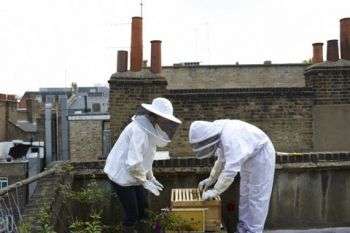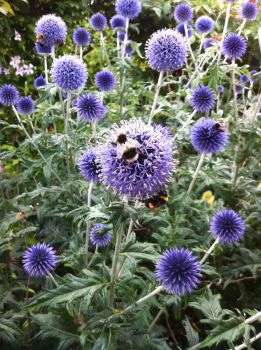Rise in urban beekeeping may have gone too far, scientists warn

University of Sussex scientists are urging people in towns and cities keen to help the honey bee not to buy a hive but to grow bee-friendly flowers instead.
The advice comes in an article in The Biologist by Professor Francis Ratnieks and Dr Karin Alton from the Laboratory of Apiculture and Social Insects (LASI) at the University of Sussex.
LASI is home to one of the biggest honey bee university research groups in the country, which is currently working on a number of projects to help honey bees, including breeding of disease-resistant queens, decoding bee waggle dances to discover where bees are foraging, helping bees in urban areas and on farmland, and research to find the best garden plants for bees and other flower-visiting insects, as well as other fundamental bee biology research.
Spurred on by widespread coverage of declining bee numbers, urban beekeeping has never been more popular, particularly in London, but the boom could be bad for honey bees and other flower-visiting insects as it risks overtaxing the available nectar and pollen supply, and potentially encourages the spread of diseases.
The article by Professor Ratnieks and Dr Alton reviews the beekeeping boom, public perception of honey bee decline and the various bee awareness campaigns that have called on the public to get involved and help the bees.
Most of the promotion of beekeeping is directed at urban areas, especially London. Data from BeeBase, a register of apiaries maintained by the UK's National Bee Unit (NBU), shows that in five
years, from 2008-13, the number of beekeepers in Greater London tripled from 464 to 1,237, and the number of hives doubled from 1,677 to more than 3,500.
At approximately 10 hives per km2, compared to approximately 1 per km2 in England as a whole, hive density is very high in London. In the five years from 2008 to 2013 the number of hives in Greater London doubled from 1,677 to more than 3,500.

And many restaurants, galleries, businesses and shops use rooftop hives as a means of visibly greening their business or as a team-building exercise for staff.
Professor Ratnieks says: "Both honey bees and wild bees have been declining. Although the causes are complex the most important one seems to be loss of flowers and habitat.
"Since World War Two the spread of intensive farming has greatly reduced areas rich in wildflowers, such as hay meadows. In the UK, 75 per cent of the total land is now agricultural, so the lack of flowers is a major problem for our bees.
"If the problem is not enough flowers, increasing the number of hives risks making that problem worse. The honey bee is just one of many insect species which feed on nectar and pollen. Having a high density of honey bee hives is not only bad for honey bees, but may also affect bumblebees and other species feeding on the same flowers.
"If a game park was short of food for elephants, you wouldn't introduce more elephants, so why should we take this approach with bees?"
With the number of urban hives on the increase, there needs to be sufficient food. Although urban areas have gardens, parks and other green areas, they also have a high proportion of buildings, roads and other non-green areas. Even the green areas often have very few flowers.
High colony density in London and an influx of inexperienced beekeepers also runs the risk of spreading certain honey bee diseases, especially American foulbrood (AFB), a highly contagious bacterial infection of honey bee larvae.
AFB is rare in Britain, but a high density of hives managed by novice beekeepers creates a situation in which it could easily spread if it got started. A few years ago there was an epidemic in Jersey. The "cure" for AFB, which has very long-lived spores than contaminate the wax combs, is to burn the hive.
Co-author Dr Karin Alton says: "Our calculations indicate that each new hive placed in London would need the equivalent of one hectare of borage, a plant that attracts mainly honey bees, or 8.3 hectares of lavender, a plant that attracts mainly bumblebees but some honey bees.
"We need to bear in mind that the honey bee may have declined but is in no imminent danger of extinction, unlike some other critically endangered insects in the UK. There are better ways to help our declining honeybee population than encouraging beekeeping to the point of overstocking certain areas.
"Rather than encouraging more hives, a better alternative would be to translate the concern that people have for bees by providing more flowers and habitat."
Professor Ratnieks adds: "It's great that the public are concerned for bees and want to help. But this enthusiasm needs to be better channelled.
"We would not want to discourage anyone from taking up beekeeping if that is what they want to do. Beekeeping can be a fascinating hobby, but should not be seen as a way of helping bees when done in areas such as London, where honey bees are already very abundant."
More information: 'To Bee or Not To Bee' is published in the Society of Biology magazine The Biologist (vol 60 no 4 Aug/Sep 2013).
Journal information: The Biologist
Provided by University of Sussex


















